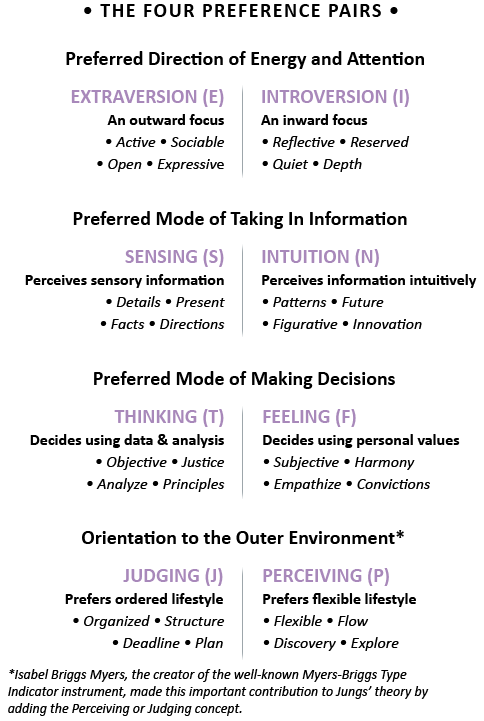What is Personality Type?
A Bit of History
We humans have probably been interested in patterns of individual personality since we began to band together to live communally.
The famous Greek physician Hippocrates described four personalities he incorporated into the medical practice of his time. Fast forward to more modern times when the famous 20th century Swiss psychiatrist Carl Jung presented a theory proposing that every person is born with certain mental patterns that influence how they interact with their environment, absorb new information, and make decisions.
The Theory of Personality Type
Psychological type theory proposes that every person is born with a set of mental preferences that represent consistent and enduring patterns. This is a lifelong developmental model that identifies four equal but opposite preferences that work together to form the core of who we are as individuals.
This theory proposes that the seemingly random behavior of people is not random at all, but falls into select patterns that indicate:
- Where individuals get their energy, in either an Extraverted or Introverted way
- How they perceive information through the process of either Sensing or Intuition
- How they make decisions through the process of either Thinking or Feeling
- How they go about their daily lives through the process of either Perceiving or Judging
The idea of a preference is an important concept in understanding the theory. Saying that we prefer a certain way of making decisions or gathering information is simply recognizing that this way is more natural for us. The preference pairs, first described by Jung and later by Katharine Briggs and Isabel Briggs Myers, can be understood as opposite but equal ways of using one's mind, like two halves that make up a whole.

Which Hand?
An often-used analogy to help explain the idea of preferences relates to handedness. Take a few seconds to write your name down on a piece of paper. Now take your non-preferred hand and repeat the exercise. We all use both hands but naturally prefer using one over the other. And most people, when asked, will reply that they are right-handed or left-handed. Their non-preferred hand most often serves in support of a physical effort and may be described as "less competent" or "more awkward" to use.
Almost everyone has more comfort and dexterity with the hand they naturally prefer, and that is the "go to" hand. The same is true for our psychological type preferences. We lead with the preferences that are most comfortable to use but the non-preferred preferences are always available for us when we need them.
Discovering Your Type
You may have heard of the Myers-Briggs Type Indicator® (MBTI®) instrument, based on Jung's theory of psychological types. It was created by Isabel Briggs Myers with a vision of making Jung's theory both practical and accessible to those who want to gain insight into the interworking of their own minds but to also learn more about the personalities of the people they care about, or need to better understand.
The Murphy-Meisgeier Type Indicator for Children® (MMTIC®) assessment (developed by Elizabeth Murphy, Ed.D. and Charles Meisgeier, Ph.D.) also measures psychological type preferences, and it is especially helpful for use with families.
Learning about type provides a positive framework that results in mutual understanding between parents and children. Type awareness presents an unusual opportunity for reducing conflict while at the same time teaching each child to respect, understand, and even appreciate the differences in people.
The Four Preference Pairs
The MMTIC® assessment, like the MBTI® assessment, identifies people as having a preference on four dimensions, all relevant to a whole or four-letter type. Remember, each side of these pairs is used by everyone, but one is usually preferred and better developed.

Your Whole Type
When the four preference pairs are combined, they result in the four-letter code that abbreviates each one of the 16 types-you may have heard people refer to themselves as being an ENFP or ISTJ. Each of the 16 types have their individual "strengths and stretches," and learning about each one goes a long way towards building better interpersonal understanding and respect in families, at school, and at work.
If you have a family of four, the odds are you will find four different personality types within that family. Knowing about your type and your children's type is helpful for fostering understanding between people who may go about living their lives in quite different ways from one another. That's OK!
The Sixteen Types
Learn more by reading the brief 16 whole type descriptions for adults or young people. As you begin to learn more about type, remember the analogy of being right handed or left handed. Both dimensions are functional and equally valuable, but everyone tends to lead with their preferred approach.
ISTJ
Quiet, serious, earn success by thoroughness and dependability. Practical, matter-of-fact, realistic, and responsible. Decide logically what should be done and work toward it steadily, regardless of distractions. Take pleasure in making everything orderly and organized - their work, their home, their life. Value traditions and loyalty.
ISFJ
Quiet, friendly, responsible, and conscientious. Committed and steady in meeting their obligations. Thorough, painstaking, and accurate. Loyal, considerate, notice and remember specifics about people who are important to them, concerned with how others feel. Strive to create an orderly and harmonious environment at work and at home.
INFJ
Seek meaning and connection in ideas, relationships, and material possessions. Want to understand what motivates people and are insightful about others. Conscientious and committed to their firm values. Develop a clear vision about how best to serve the common good. Organized and decisive in implementing their vision.
INTJ
Have original minds and great drive for implementing their ideas and achieving their goals. Quickly see patterns in external events and develop long-range explanatory perspectives. When committed, organize a job and carry it through. Skeptical and independent, have high standards of competence and performance - for themselves and others.
ISTP
Tolerant and flexible, quiet observers until a problem appears, then act quickly to find workable solutions. Analyze what makes things work and readily get through large amounts of data to isolate the core of practical problems. Interested in cause and effect, organize facts using logical principles, value efficiency.
ISFP
Quiet, friendly, sensitive, and kind. Enjoy the present moment, what's going on around them. Like to have their own space and to work within their own time frame. Loyal and committed to their values and to people who are important to them. Dislike disagreements and conflicts, do not force their opinions or values on others.
INFP
Idealistic, loyal to their values and to people who are important to them. Want an external life that is congruent with their values. Curious, quick to see possibilities, can be catalysts for implementing ideas. Seek to understand people and to help them fulfill their potential. Adaptable, flexible, and accepting unless a value is threatened.
INTP
Seek to develop logical explanations for everything that interests them. Theoretical and abstract, interested more in ideas than in social interaction. Quiet, contained, flexible, and adaptable. Have unusual ability to focus in depth to solve problems in their area of interest. Skeptical, sometimes critical, always analytical.
ESTP
Flexible and tolerant, they take a pragmatic approach focused on immediate results. Theories and conceptual explanations bore them - they want to act energetically to solve the problem. Focus on the here-and-now, spontaneous, enjoy each moment that they can be active with others. Enjoy material comforts and style. Learn best through doing.
ESFP
Outgoing, friendly, and accepting. Exuberant lovers of life, people, and material comforts. Enjoy working with others to make things happen. Bring common sense and a realistic approach to their work, and make work fun. Flexible and spontaneous, adapt readily to new people and environments. Learn best by trying a new skill with other people.
ENFP
Warmly enthusiastic and imaginative. See life as full of possibilities. Make connections between events and information very quickly, and confidently proceed based on the patterns they see. Want a lot of affirmation from others, and readily give appreciation and support. Spontaneous and flexible, often rely on their ability to improvise and their verbal fluency.
ENTP
Quick, ingenious, stimulating, alert, and outspoken. Resourceful in solving new and challenging problems. Adept at generating conceptual possibilities and then analyzing them strategically. Good at reading other people. Bored by routine, will seldom do the same thing the same way, apt to turn to one new interest after another.
ESTJ
Practical, realistic, matter-of-fact. Decisive, quickly move to implement decisions. Organize projects and people to get things done, focus on getting results in the most efficient way possible. Take care of routine details. Have a clear set of logical standards, systematically follow them and want others to also. Forceful in implementing their plans.
ESFJ
Warmhearted, conscientious, and cooperative. Want harmony in their environment, work with determination to establish it. Like to work with others to complete tasks accurately and on time. Loyal, follow through even in small matters. Notice what others need in their day-by-day lives and try to provide it. Want to be appreciated for who they are and for what they contribute.
ENFJ
Warm, empathetic, responsive, and responsible. Highly attuned to the emotions, needs, and motivations of others. Find potential in everyone, want to help others fulfill their potential. May act as catalysts for individual and group growth. Loyal, responsive to praise and criticism. Sociable, facilitate others in a group, and provide inspiring leadership.
ENTJ
Frank, decisive, assume leadership readily. Quickly see illogical and inefficient procedures and policies, develop and implement comprehensive systems to solve organizational problems. Enjoy long-term planning and goal setting. Usually well informed, well read, enjoy expanding their knowledge and passing it on to others. Forceful in presenting their ideas.
Excerpted from Introduction to Type® by Isabel Briggs Myers published by The Myers-Briggs Company. Used with permission.
Type may not explain all aspects of your personality or behaviors. But, as Isabel Myers said in her book Gifts Differing, learning about type helps us make "constructive use of differences."
It really does take all stripes, and all types!



_thumb.png)




